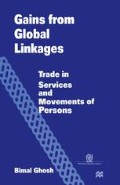Abstract
A major achievement of the Uruguay Round of trade negotiation is the establishment for the first time of a rules-based multilateral system for international trade in services and the initiation of a continuing process of its liberalization in the same way as the GATT has done since 1947 for trade in goods. The agreement, known as the General Agreement on Trade in Services (GATS), forms part of the Final Act of the Uruguay Round, and covers trade in all service sectors. The basic aims are the expansion of trade in services of all participating nations and the enhancement of its contribution to the world economy.
Access this chapter
Tax calculation will be finalised at checkout
Purchases are for personal use only
Preview
Unable to display preview. Download preview PDF.
Notes and references
GATT Secretariat, GATS: The General Agreement on Trade in Services and Related Instruments (Geneva: April, 1994).
See, in this connection, UNCTAD/The World Bank, Liberalizing International Transactions in Services: A Handbook (New York and Geneva: United Nations, 1994) pp. 144–48.
See, in this connection, GATT Secretariat, The Results of the Uruguay Round of Multilateral Trade Negotiations (Geneva: November 1994). Much of the statistical information used in this and the following sections is drawn from this document and other GATT sources.
The country groupings correspond to those used by the GATT/WTO Secretariat. The ‘maximum possible’ is based on the total number of activities multiplied by the number of countries in each group. Sources: GATT 1994; Carlos Primo Braga, ‘The Internationalization of Services’. (Washington, DC: World Bank, International Economics Department, 1995).
GATT, Compilation of Horizontal Commitments: All Sectors. Information Note by the Secretariat (Geneva: 21 June 1994). Also: Results of the Uruguay Round of Multilateral Trade Negotiations (November 1994) op. cit.
See, in this connection, L. Altinger and A. Enders, ‘The Scope and Depth of GATS Commitments’ (1995) mimeo, p. 13.
UNCTAD/The World Bank, Liberalizing International Transactions in Services: A Handbook (1994) op. cit. p. 149
See, in this connection, UNCTAD document TD/B/CN4/43 (Geneva: 30 June 1995).
GATT Secretariat, The Results of the Uruguay Round of Multilateral Trade Negotiations (November 1994) op. cit. p. 40.
Copyright information
© 1997 International Organization for Migration
About this chapter
Cite this chapter
Ghosh, B. (1997). The General Agreement on Trade in Services (GATS) and Movement of Natural Persons. In: Gains from Global Linkages. Palgrave Macmillan, London. https://doi.org/10.1007/978-1-349-25422-4_5
Download citation
DOI: https://doi.org/10.1007/978-1-349-25422-4_5
Publisher Name: Palgrave Macmillan, London
Print ISBN: 978-1-349-25424-8
Online ISBN: 978-1-349-25422-4
eBook Packages: Palgrave Economics & Finance CollectionEconomics and Finance (R0)

